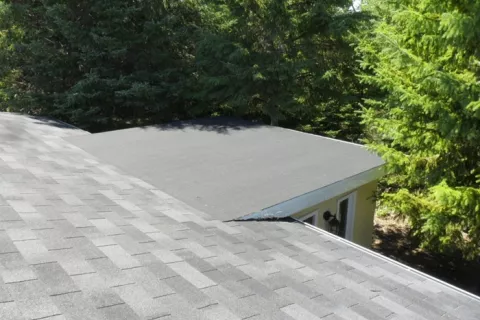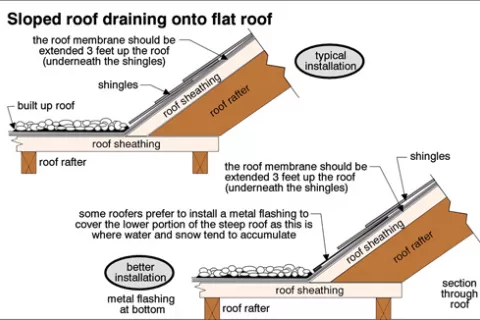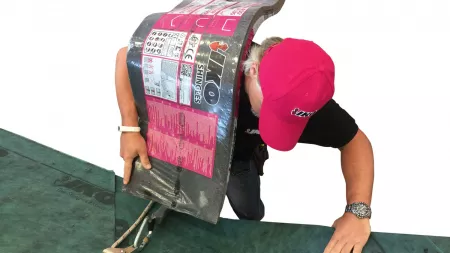
How to connect a flat roof to a shingle roof?
Enlarging the living area of your house or building project often requires the reconstruction or remodeling of some parts of this building. Most of the time the existing roof is not suitable for the house addition, so installing a new roof over the additional square meters is usually required. When coming across a renovation project nowadays, you often see people choosing for a flat roof construction. This flat roof is an excellent and economical choice for an addition. A flat roof can be connected to the existing slope roof of the house and gives a very contemporary look to the newly added space.
Flat roof connected to pitch roof
A flat roof isn't actually flat; it has a slope of 2° - 3°. It appears to be flat, but it needs a slope to allow the water to drain from the roof. For slopes less than 9,5° we cannot install roof shingles. Instead the roof must be done with a modified bituminous membrane (e.g. Armourvalley) or other materials like EPDM, PVC or TPO covering.

Use of underlay and bituminous membrane
The colors of IKO Armourvalley membranes are matching the colors of IKO shingles. This creates the same beautiful look as on the main roof. Armourvalley is a high quality APP modified roll especially for roof valleys but it can also be used for low slope roof areas that are not suitable for shingles. Armourvalley cannot be applied directly on a wooden deck. First an underlay (e.g. Armourfix) must be installed as a base sheet. Armourfix is an underlay for IKO Armourvalley. This underlay must be applied with a good mechanical fastening; this means roofing nails or screws every 20 cm in all directions. Afterwards the IKO Armourvalley must be fully torched on it.

A very important detail is where the flat roof is connecting the pitch roof. Armourfix and Armourvalley membranes must be installed and extended 60 - 90 cm up the main roof underneath the shingles in order to assure a waterproof connection.
The starter strip and first row of shingles must be applied 25 cm from the bottom of the slope roof (or main roof) above the slope transition. The starter strip must be securely glued on the Armourvalley membrane.

Tip! Some roofers install a metal flashing under the starter strip to protect the lower part of the roof to accumulate water and snow loads.
Important! Remember: the slope of a flat roof must allow the water to drain from the roof. If water is not drained from the roof, any weak detail can be a potentially leakage in future!



